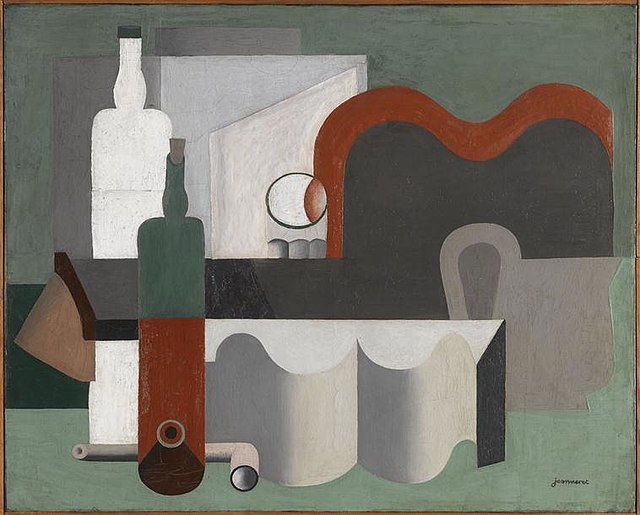Purism, referring to the arts, was a movement that took place between 1918 and 1925 that influenced French painting and architecture. Purism was led by Amédée Ozenfant and Charles Edouard Jeanneret. Ozenfant and Le Corbusier formulated an aesthetic doctrine born from a criticism of Cubism and called it Purism: where objects are represented as elementary forms devoid of detail. The main concepts were presented in their short essay Après le Cubisme published in 1918.
Le Corbusier, 1922, Nature morte verticale (Vertical Still Life), oil on canvas, 146.3 cm × 89.3 cm (57.6 by 35.2 inches), Kunstmuseum Basel
Le Corbusier, 1921, Nature morte (Still Life), oil on canvas, 54 x 81 cm, Musée National d'Art Moderne
L'Esprit Nouveau, No. 1, October 1920. Edited by Paul Dermée and Michel Seuphor, later by Charles-Edouard Jeanneret (Le Corbusier) and Amédée Ozenfant. Published by Éditions de l'Esprit Nouveau, Paris
Amédée Ozenfant, 1921, Nature morte au verre de vin rouge (Still Life with Glass of Red Wine), oil on canvas, 50.6 x 61.2 cm, Kunstmuseum Basel
Amédée Ozenfant was a French cubist painter and writer. Together with Charles-Edouard Jeanneret he founded the Purist movement.
Amédée Ozenfant, 1920–21, Nature morte (Still Life), oil on canvas, 81.28 cm x 100.65 cm, San Francisco Museum of Modern Art
L'Esprit Nouveau, No. 1, October 1920. Edited by Paul Dermée and Michel Seuphor, later by Charles-Edouard Jeanneret (Le Corbusier) and Amédée Ozenfant. Published by Éditions de l'Esprit Nouveau, Paris
Amédée Ozenfant, 1920, Still Life, Dishes, oil on canvas, 72 x 59.5 cm, Hermitage Museum
Amédée Ozenfant, 1921, Nature morte au verre de vin rouge (Still Life with Glass of Red Wine), oil on canvas, 50.6 x 61.2 cm, Kunstmuseum Basel






